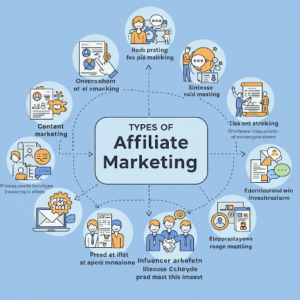
Introduction
Affiliate marketing considered a popular way of making money online by advertising for other companies. Affiliates, therefore, earn commissions on products or services sold or actions taken through their referral links. The whole digital marketing mechanism allows an individual to earn without producing their own products; hence the ease of entering the business.
With the growing number of online shoppers and digital platforms, affiliate marketing has now decorated itself for not only novice but also professional marketers who want to create passive income streams. Successfully running an affiliate program involves the right choice of products and having the right target audience.
What Is Affiliate Marketing
As such, affiliate marketing serves a specific individual or business to promote a certain product or service for a commission. To be an affiliate marketer is earning money by recommending products or services. Once someone buys a product through your referral link, you place a commission for it.
In summary, digital marketing serves businesses that want to promote their products and affiliates who can bring customers to them. These affiliates usually earn commissions on sales made through their referrals.
How Does Affiliate Marketing Work

Essentially, there are three parties in an Affiliate Marketing Relationship:
- The Merchant (Seller): This person or company creates or owns the product or service being marketed.
- The Affiliate (You): This is the person or company who advertises the products for potential customers.
- The Customer: The person who buys the product or service through the click of the affiliate’s link.
Here’s a simple breakdown of how it works:
- You Join an Affiliate Program: Choose the product or service you will be promoting. You sign up for the affiliate program offered by the particular merchant or through one of the affiliate networks out there, such as Amazon Associates, ClickBank, or ShareASale.
- Promote the Product: On your website, social media pages, or email lists, you will place a unique affiliate link. The link monitors any purchases made by customers clicking on it.
- Customer Makes a Purchase: A prospective customer clicked on your affiliate link, plus they purchased it.
- Earn Commission: Business, the merchant tracks the sale and credits you with a commission, which is more often than not a specific percentage of the sale price.\
What Are the Types of Affiliate Marketing

Affiliate marketing offers multiple methods of product promotion. Here are the commonly used ways:
1. Content Marketing
Creating good-quality content, such as blogs, reviews, or tutorials that have affiliate links, is one of the most favored methods. It can help your content inform, educate, and persuade the reader to click on the affiliate links.
2. Email Marketing
Another popular method used by affiliate marketers for product promotion is to send emails to their subscribers. While sending valuable content and promotions, you can persuade your subscribers to go and visit affiliate offers.
3. Social Media Marketing
Another huge way to promote affiliate products would be through social media platforms like Instagram, Facebook, or Twitter, which would greatly assist you in reaching out to a larger audience. This method is extensively used by many influencers to promote the products offered to them for commissions.
4. Paid Advertising
Some affiliates pay for ads through Google or Facebook to drive traffic to their links. Although this method is an investment, it can yield fast results when properly managed.
5. Video Marketing
Video platforms like YouTube provide far-reaching potential for affiliate marketers. Review and demo videos allow you to include affiliate links in the video description directly and urge viewers to click through and purchase.
What Are the Benefits of Affiliate Marketing

Affiliate marketing offers a wide range of benefits for individuals and businesses alike:
- Low Startup Costs: Compared to establishing any other sort of business, affiliate marketing requires very low initial investments. There is no need for product development or for customer-service management. All that is needed is a platform from which to promote products.
- Flexible Work Schedule: Affiliate marketers have the liberty to work when and where they want. In case you are inclined to work part-time or full-time, what is digital marketing gives you the liberty to choose your own schedule.
- Passive Income: After creating your affiliate marketing system, it can generate money in autopilot mode. You could earn commissions as you sleep or during vacations.
- Scalable: You can expand your affiliate marketing activities by promoting more products, targeting a bigger audience, or using other marketing channels.
- No Inventory or Shipping: Your only concern will thus be driving traffic and making sales, as there will be no inventory, packaging, or shipping to deal with.
- Earn From Multiple Sources: You can benefit from promoting products from various merchants, thus having the potential to earn from several affiliate programs.
Pros and Cons of Affiliate Marketing
Affiliate marketing offers a great opportunity for earning income online, but like any business model, it comes with both advantages and challenges. Here’s a look at the pros and cons.
Pros:
- Low Startup Costs
Affiliate marketing doesn’t require a large initial investment. You don’t need to create products or manage inventory, making it a low-risk way to get started.
- Passive Income
After it has been set, affiliated marketing requires little maintenance for generating income. If strategized correctly, money can be made with life support.
- Flexibility
You can work anywhere, any time. Affiliates set their own working timetable, so the schedule is free depending upon the terms of the affiliate marketer.
Cons:
- No Control Over Products
Since you do not manufacture or manage the product, you depend upon the merchants for product quality and customer service. Any problems that arise would almost certainly reflect on your reputation.
- Competition
A lot of marketers are after the same products, making it difficult to create a niche or sale.
- Income Isn’t Guaranteed
Affiliate marketing requires a lot of time and effort to begin to work in a major way. Income can be volatile, and it may take some time for a steady income to build up.
Why You Should Get Into Affiliate Marketing
Affiliate marketing represents one of the most convenient methods through which one can make money online. Whether an individual wants additional income or a full-time business, there is ample opportunity for growth. It is primarily focused on creating easy income for those who want to recommend products they believe in, while also developing that same interest.
This has been a relatively simple introduction to affiliate marketing but brought along huge income potential, and with the right strategy and the right commitment, anyone can be successful.
How Do Affiliate Marketers Get Paid?
Affiliate marketers earn money by promoting products and earning commissions on sales or leads. There are several payment models that determine how affiliate marketers get paid:
- Cost Per Sale (CPS)
This means that the marketer is paid a commission for every sale made from the affiliate link. Most of these commissions are a certain percentage of the sale price.
- Cost Per Lead (CPL)
This is the way of earning money through actions, for example, where someone fills out a form or signs up for the newsletter via the affiliate link.
- Cost Per Click (CPC)
Here, Affiliate marketers are paid according to clicks generated on the affiliate link, regardless of whether there is a sale.
- Recurring Commissions
For subscription-based services, marketing and digital marketing marketers earn a commission each time a customer renews their subscription.
Payment methods may vary, but most affiliates receive payments through PayPal, bank transfers, or other online payment services.
Common Types of Affiliate Marketing Channels
The various channels used by affiliate marketers to promote a product and earn commissions come with unique sets of advantages, and the choice of appropriate channels can turn heavily in favor of your success. Here are some of the most common affiliate marketing channels.
- Blogs and Websites
The blog or website is a fundamental tool of the affiliate marketer. Content development ought to be high quality, ranging from product reviews, tutorials, or articles about the specific domain, developed in order to attract readers and expose them to the affiliate products. The key here would be to blend the affiliate links naturally within the content so the user experience is not disrupted, thus leading to higher conversion rates.
- Social Media Platforms
Social media acts as an exciting medium for reaching wide audiences. Affiliate marketers share links on Instagram, Facebook, Twitter, and TikTok. Engaging posts, video updates, and stories attract audiences to products. The visual standpoint gives social appreciation-so they introduce and promote products comfortably.
- Email Marketing
Affiliate marketers have a powerful opportunity through Email Marketing to create relationships directly with their audience. By providing valuable content to their audience, such as newsletters, they can insert affiliate links for products they recommend. Well-crafted emails sent regularly can keep an audience’s interest alive for growing affiliate sales.
- YouTube
Video marketing has come up as an important avenue for affiliate marketers. Product reviews, unboxing, or how-to videos on YouTube allow marketers to incorporate affiliate links into their offerings. The video format provides a dynamic way to demonstrate product functionality and persuade audiences to make purchasing decisions.
- Paid Advertising
Paid ads through Google Ads or Facebook Ads can assist affiliate marketers targeting the desired audience. Using these highly optimized advertisements generates direct traffic to affiliate products.
By using a combination of these channels, digital marketing services can maximize their reach and increase their chances of success.
Tips to Help You Become a Successful Affiliate Marketer
This program provides a platform for passive income by promoting products and services of other firms. While it may look simple, one requires a strategy, hard work, and consistency to survive this domain. Here are some useful tips for making affiliate marketing work for you.
- Pick the Right Niche
Select a niche you are interested in and which has good market demand. A niche allows you to target specific audiences and build authority. Thus, one needs to pick a niche that excites them as well as has the potential for profit. Weigh several niches and find out what products or services pique the interest of your target audience in that niche.
- Select Quality Affiliate Programs
Join only credible affiliate programs. Go for programs that provide good-quality products or services in your niche. Go by reputed companies with good customer support and reliable payment systems. The better the products, the easier it will be to promote to your audience effectively.
- Build Trust with Your Audience
To make money, you need to earn a name among your audience. Write reviews that are honest and sincere, and do not promote products that you would not recommend to others. Trust is the basis of affiliate marketing; if your audience feels that you really want to help them, they are more likely to purchase through one of your affiliate links.
- Create Valuable Content
Put out any material that answers the needs and questions of that audience. Provide value, whether it’s blog posts, videos, or social media content. The more value you provide, the more often your audience will look to you to provide that value, increasing your chances for affiliate sales. Focus on solving problems or answering questions pertinent to your niche.
- Utilize Multiple Channels
Extensive promotion of affiliate products should not necessarily rely on one channel. Use several channels, such as your site, YouTube, different social media sites, and email newsletters. A good mix of marketing channels reaches a wider audience, thus improving conversion chances.
- Track and Analyze Your Results
Measure your performance in what is seo in digital marketing via appropriate analytic tools. Tracking clicks, conversions, and commissions shows you what works and what needs improvement. Use your results to adjust your strategy so as to maximize earnings.
- Stay Consistent and Be Patient
Affiliate marketing is not a mill for instant cash. It demands some time, patience, and persistence. Stay consistent and just go on promoting products, creating content, and engaging with your audience. Eventually, your hard work will pay off.
By applying these tips and persisting through the hard times, you should set the foundation for earning a steady income and achieving success in the affiliate marketing field.
How Do I Create and Implement an Affiliate Marketing Strategy
Affiliate marketing is one of the strongest tools that can radically elevate the profit levels of a business with the right partners in place to exploit their audience. To build an affiliate marketing strategy that works and carry it out, clear cutting, the right tools, and consistent use of the tools will be needed.
Step-by-step process to formulate a solid affiliate marketing strategy starts with:
1. Set Clear Goals and Objectives
Start by knowing what goals you would like to have. Is it for sales, lead generation, or just building awareness of your brand? Set tangible standards like conversion rates or revenues realized. The importance of having clearly defined goals is that it will enable tracking of success as well as adjustment of the strategy if need be.
2. Choose the Right Affiliate Program
Making the right choice in affiliate programs is a critical aspect of setting up an affiliate marketing strategy. Look for affiliate programs that best fit well with what you do or sell and who your audience really is. Consider networks that have competitive commission structures and are highly reputed in making payments on time. There is homework to do once you find wholesale suppliers that are reliable and credible.
3. Find and Recruit Affiliates
Then create an entire group of affiliates that can channel your products and services into the public eye. Find suitable resellers that have customers similar to the products or services you sell. Find affiliates who have a good presence, whether it be online with their blog, YouTube channel, or social accounts. Contact them directly with a clear pitch of what they’ll gain by working with you.
4. Develop a Clear Affiliate Agreement
Prior to any work done with what is online marketing, create a partnership contract clearly outlining what to expect on everything, including payment terms, commission rates, and all relevant details. Both parties should understand how the partnership is going to unfold to avoid confusion down the road.
5. Provide Quality Marketing Materials
Ensure your affiliates can easily promote your product by providing them with professional marketing materials to include banners, links, email templates, and product images. Supplying affiliates with tools simplifies the uniformity of message and bets on successful promotions.
6. Track and Monitor Affiliate Performance
When your affiliates start advertising your products, you should track their performance on a regular basis. Use tracking software to measure clicks, conversions, and commissions. This will help you identify who are performing well and which of your affiliates need guidance or re-alignment in their strategy.
7. Optimize and Improve Your Strategy
One of the factors that all affiliate marketing strategists should remember is that affiliate marketing does not set and forget. You need to keep a watch on your strategy incessantly and constantly search for opportunities to get better results. If specific affiliates bring about better results than others, you may want to consider giving them more commission or visibility. Usually, coming up with such a strategy proves beneficial in staying competitive and maximizing results.
Get Started with Affiliate Marketing Today
Affiliate marketing is great passive income since you promote products or services and earn commission per sale from your referral. The first step is picking a niche that interests you, whether it’s fitness, technology, or fashion, as this will make creating content easy for your intended audience.
Next, enroll in affiliate programs for matching niches. Tons of companies offer affiliate marketing opportunities—Amazon, ShareASale, and Commission Junction are just the mere mentionings. Once you join, start promoting affiliate links on your blog, YouTube channel, and social media.
Provide honest reviews, useful tips, or tutorials for the audience. The more authentic and helpful your content is, the more strangers will trust your recommendations and make purchases.
Though affiliate marketing entails commitment and patience, it slowly grows into a regular income if you put in motivation and effort. Start now in grabbing your online earning opportunities!